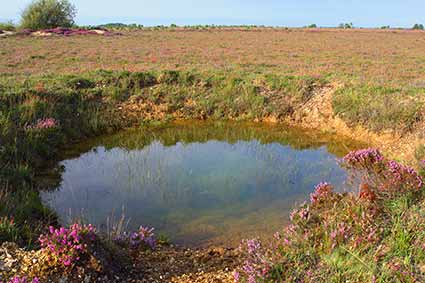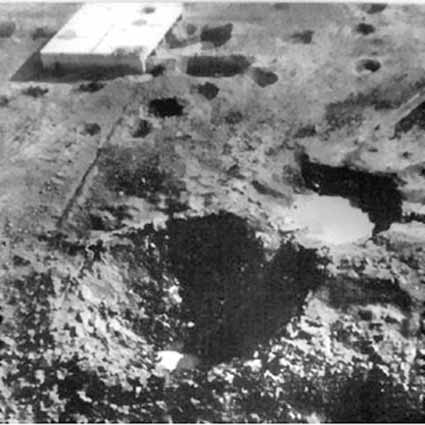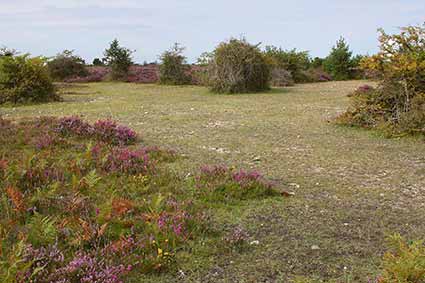Ashley Walk Bombing Range

In what was then a remote part of the northern New Forest, two major Second World War military facilities were present - the Ashley Walk Bombing Range and, just across the Fordingbridge road, the Armaments Research Department, Millersford.
Established in mid-1940, the Ashley Walk Bombing Range was the larger of the two, covering more than 2,025 hectares (5,000 acres) enclosed by 14.5 kilometres (9 miles) of supposedly impenetrable 1.8 metres (6 feet) high chain link fencing.
Shattering the peace and quiet of this idyllic landscape, Mosquitos, Lancaster Bombers and American, Flying Fortresses unleashed deadly cargoes of explosives. Bombs were tested, and so were bombing techniques and methods of delivery, paving the way for drops on German cities and other installations.
Just about every type of bomb available for delivery from the air was tested, with the exception of incendiary devices that would have risked starting heathland fires. Bombs ranged in size from small anti-personnel bombs up to wartime’s heaviest bomb, an almost 10,000 kilos (22,000 lbs) beast known as the ‘Grand Slam’ that left a crater 40 metres (130 feet) across and over 21 metres (70 feet) deep.
Specially built targets were laid down and, where necessary, reinforced to withstand the constant pounding.
Two enormous ‘wall’ targets, for example, were constructed, each comprising two parallel walls over 12 metres (40 feet) wide and 12 metres (40 feet) high, whilst a smaller wall provided test facilities for the “Bouncing Bombs’ of Dr. Barnes Wallis, the bombs of Dam-Busters fame.
Marked out with chalk brought from outside the New Forest, a ‘Line Target’ 3 metres (10 feet) wide and 1,830 metres (6,000 feet) long, terminated by a massive cross, simulated an enemy railway line.
A ‘Ship Target’ was constructed from huge rectangular steel plates, whilst obsolete or redundant aircraft, lorries, tanks and other vehicles were parked on the range, waiting to be blown to smithereens.

bomb crater and Ministry of Home Security Target
Fragmentation bombs were tested against slit and air-raid trenches containing wooden dummies – these bombs, designed to explode in mid-air, were unleashed to establish the extent of damage caused by the flying fragments; whilst twenty-four pens were also constructed, each to contain an old or unwanted aircraft, to test the protective characteristics of the pen.
Two airstrips were also laid down, control and observation towers were built, and brick observation huts, too, whilst men working on the range were billeted in huts on the lawn opposite the Fighting Cocks inn, at nearby Godshill, uncomfortably close, it seems, to the areas of operation.
But perhaps most intriguing of all was a structure built close to Ashley Cross, a little to the south-east of Pitts Wood Inclosure. Originally known as the Ministry of Home Security Target, and subsequently as the Submarine Pens, this relatively large building was until quite recently thought to have been constructed to replicate shelters positioned along the French coast, specifically placed to harbour deadly World War Two, German submarines; and to then provide facilities for bomb tests in advance of attacks on these submarine bases.
The building now, though, is considered to have been an above-ground, reinforced concrete shell used to test response to bombs, some of which were exploded from within. It did, however, withstand the onslaught and despite taking a number of direct hits, resisted substantial damage. At the end of hostilities, the target proved impractical to remove. It was eventually buried and for many years had the appearance of a large, vegetation-topped mound with concrete pushing through in places where the forces of wind and rain had removed parts of the earthen covering.
Yet uncertainty about exactly what lies beneath the mound continues, so-much-so that in early 2014 a series of sophisticated tests using ground penetrating radar and electrical imaging were commissioned to peer through the soil. The results are awaited with interest, particularly as it has been suggested that buried bombs and aircraft parts lie within the structure's internal chambers.
The existence of human habitation in this part of the New Forest long pre-dates World War Two, however, as can be seen by the prior presence of two dwellings that were largely destroyed by bombing range activity.
The first, Ashley Lodge, located to the north of Pitts Wood, was reached by a track that became known as the Snake Road. The road was used as a means of access to the Bombing Range, and is now used by walkers and other leisure users.

Rebuilt in 1773, the property was wisely abandoned when the bombing range was established, and was so badly damaged that it was demolished after the war. Little evidence of former occupation remains, save for occasional fruit trees now run wild, old field boundaries, remnants of the keeper’s meadow, and the name of nearby Lodge Hill.
The second dwelling, Amberwood Cottage, a woodman’s residence in 1900, stood on the northern edge of Amberwood Inclosure, close to Ashley Cross. It, too, was badly damaged by bombing, and subsequently demolished, although its stable block foundations and some garden trees – yews and laurels - can still be seen today.
References:
Ashley Walk – Its Bombing Range, Landscape and History: Anthony Pasmore and Norman Parker
More links
Other related links
Search this site

Sadly, 58 animals were killed - 35 ponies, 13 cows, 8 donkeys and 2 sheep, whilst a further 32 were injured - 3 pigs, 9 donkeys, 11 cows and 9 ponies.
(Forty-three accidents occurred in daylight, 15 at twilight and 101 in the dark. Twenty-seven accidents were not reported by the driver involved).
Here's just one horrific example - Three donkeys killed in collision with van at notorious New Forest blackspot (Advertiser and Times)
Sika deer continue to engage in rutting behaviour, and will do so until December.
Pigs seek out the remains of the acorn crop.
Beech leaves are transformed into a magnificent mosaic of glorious reds and golds. Other deciduous trees, too, take on an autumnal cloak before their leaves fall.
Dragonflies can occasionally be seen on the wing on bright days early in the month.
December
Foxglove leaves survive the winter at ground level, and offer the prospect of colourful summer blooms to come.
Redwings and fieldfares, autumn and winter visitors, gorge on haws and holly berries.
Great grey shrikes and hen harriers hunt over the heaths and other open spaces.
Honeysuckle by the end of the month often shows welcome signs of new growth.

